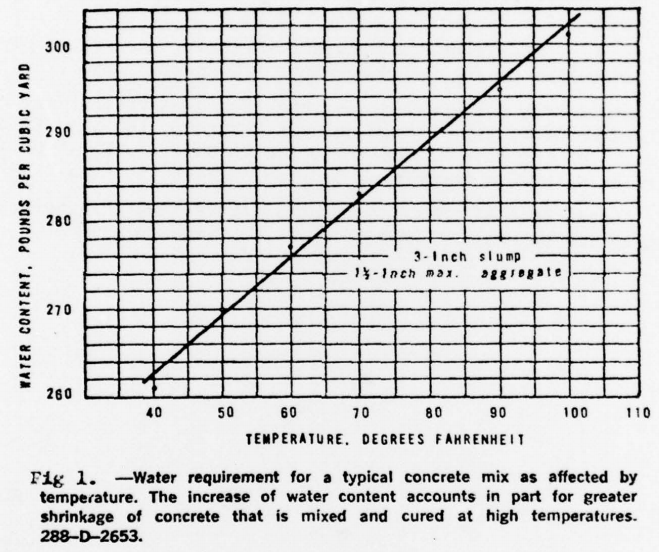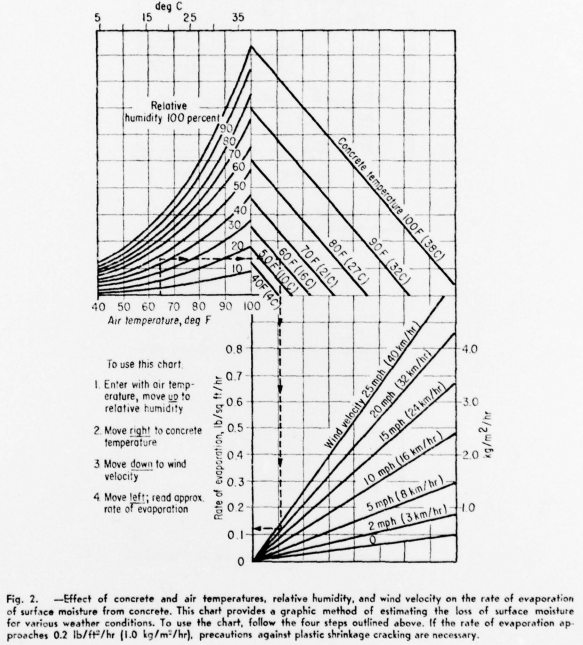quality control in hot weather
As you have discovered, during hot weather temperature is not the only hindrance to quality concrete. We have to be very concerned with relative humidity and wind velocity. In order to establish good quality control procedure, we need to know when the conditions are detrimental to the production of quality concrete construction. Concrete is a material which can be used and should be used during all periods of the year: there isn't any reason for a 50 percent reduction of concrete production during the winter and absolutely no excuse for placement of poor quality concrete during hot summer conditions. Quality control is very important under all conditions but even more important during hot and cold weather concreting conditions.
As you have heard, hot weather effects on concrete in the plastic state may include:
- Increased water demand
- Increased rate of slump loss
- Increased rate of setting
- Increased tendenct for plastic cracking
- Increased difficulty in controlling entrained air content.
From a quality control standpoint, what can we do prevent these problems?
1 and 2 can be controlled by proportioning your concrete for the conditions to which it will be exposed in the field. A concrete mixture which in February gave you a 3-in (76mm) slmup and 4000 psi(27.5 MPa) concrete may, when controlled by slump in August, give you a 3-in (76mm) slumd and 3200 psi (22MPa) due to the increased concrete temperature which requires an increase of approximentaly 40 pounds (18kg) of water to maintain the same slump. (see Figure 1). If concrete is going to be placed at 90 F (32C), it should be proportioned for placement at that temperature. Hot-weather concrete requires a higher water requirement than cold-weather concrete to maintain the same slump. Either one two adjustments can be made. You can increase the cement content in order to maintain the same water-to-cement ratio as the cold weather concrete or decrease the hot weather concrete temperature to the temperature used during the winter. I personally believe the answer is a combination of these two adjustments: adjust the mixture by slightly increasing the cement and water content, and decrease the placing temperature to reduce the increased water demand and slump loss. 3, 4 and 5 can be controlled by reducing concrete placing temperatures, using a retarder and employing protection from the wind, combined with the use of adequate curing (see Figure 2) Setting time decreases with increased temperature; plastic cracking increases due to increased water demand and rapid evaporation; quantity of air-entraining agent increases with in-creased temperature.


Field Test Conditions and Methods
As discussed above, a technician who controls concrete during changing seasons by use of the slump test is asking for trouble; slump concrete in August will not have the same water content in as a slump concrete in April. For good quality control, adjustments should be made to the mix, including increasing the amount of cement and water so that the original acceptable W/C ratio is maintained. The slump test should be performed as required in ASTM C-143.
Inspection Before Concreting
Good quality control includes the three-step approach to inspection. These three steps include:
- Preparatory Phase. This phase should be performed prior to beginning any work and should include a review of contract requirements.
- Initial Phase: This phase should be performed as soon as work begins on a representative portion of the job and should include assurance that the decisions made during the prepartory phase are being implemented and are working satisfactorily.
- Follow-up Phase: This phase should be performed dailty to assure continued compliance.
Ideally all possible problems should be anticipated during the preparatory phase, but, if they are not, the system should be flexible enough to correct problems as the arise.
During the preparatory phase of anticipated hot-weather concreting, we should follow the stipulations below.
Provisions For Placing
- A relatively low-heat cement should be used; do not use Type II or a finely ground cement unless absolutely necessary.
- The concrete should be mixed at the coolest temperature economically possible.
- The haul distance should be the shortest possible.
- The waiting time to unload should be the shortest possible.
- The placement should be ready for concrete as soon as it arrives.
- The placement should occur during the coolest part of the day.
- The subgrade should be as cool as possible.
- The concrete should be placed and consolidated as rapidly as possible.
Provision for Curing
- plan for fog curing, if possible. Water curing, membrane curing and water, and membrane curing alone are listed in order of decreasing effectiveness.
- Plan to cure in a way which will reduce heat buildup in the concrete
- If membrane curing is used, use the white-pigmented type so extreme heat wil be reflected.
- If feasible, use insulation during evenings and night in environments where the temperature drops considerably at night.
Provision For Protection
- If possible, shade placed concrete from the sun and wind. Exposure to either can adversely affect the finish product.
- Protect it from rains, especially relatively cold fall rains which cause rapid cooling
- See 4 at Provision For Curing
Inspections During Concreting
In the three phase system of inspection, two phases, initial and follow up, occur during concreting. All of the problems which come up during concreting should have been anticipated during the preparatory phase. During concreting operations, the time period during which you can effectively bond new concrete to older concrete is significantly decreased. Therefore, if you are placing a wall, you may have to reduce the lift size so that the time-lapse between lifts can be reduced. Otherwise, cold joints will occur.
The slump of hot-weather concrete can disappear quickly due to the temperature of the concrete, the ambient temperature, the wind and relative humidity; therefore, the concrete should be placed and consolidated as soon as possible. After the quantity of water proportioned for the mix has been mixed into the concrete, re tempering the addition of more water-should never be attempted unless you are willing to accept the resulting loss of strength and durability and increase in cracking and shrinkage. Do not control your concrete on slump alone; make certain that the W/C ratio is not exceeded if you want quality concrete. Maximum time periods between mixing and placing are not technically desirable. If the concrete is workable and has not been re-tempered, It should be acceptable. Uniformity of the concrete is very important for hot weather concreting. This includes uniformity of temperature of the ingredients, mixture proportions, quantities of ingredients, mixing time, W/C ratio, and air content. Some of the other conditions which should he uniform include: delivery time, placing time, finishing, curing, and protection. The use of a retarder normally allows greater flexibility in the uniformity of these conditions.
The greater the uniformity, the fewer the problems encountered and the better the quality obtained. Frequent air content tests should be made. Too often a slump test may come up low and water is mistakenly added when the mixture really needed additional air entrainment
Inspections After Concreting
Young concrete needs tender loving care, especially during extreme weather conditions. This care is not complete immediately following placement and finishing. As mentioned above, you may want to insulate the surface during reduced evening and nighttime ambient temperatures. Curing is one of the most important yet ignored phases of concrete construction. Under hot weather conditions concrete can dry very rapidly and shrinkage cracking can result. If moisture is driven out and not replaced, the concrete can become dormant and stop acceptable strength gain. Cement requires moisture to hydrate and grow stronger. Normally the mix water is ample moisture for the hydration process; but during hot arid weather, especially in the case of thin concrete sections, this moisture may evaporate and not be available to the cement.
Conclusion (Hot Weather)
- Do a good job of quality control
- Anticipate problems
- Plan to alleviate these problems
- Obligate yourself to a good evaluation program
- Use a mixture proportioned for the hot weather and other ambient conditions.
- Assure uniformity of concrete, mixing, delivery, placement, finishing, curing and protection.
